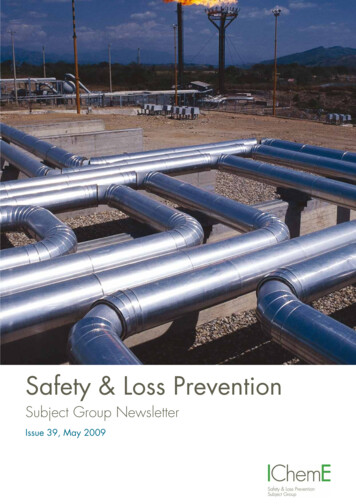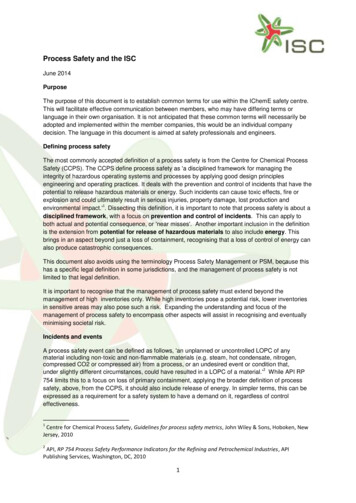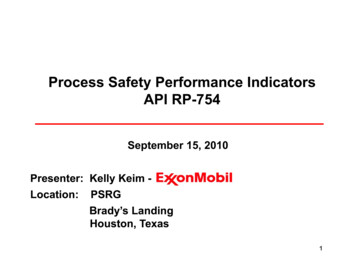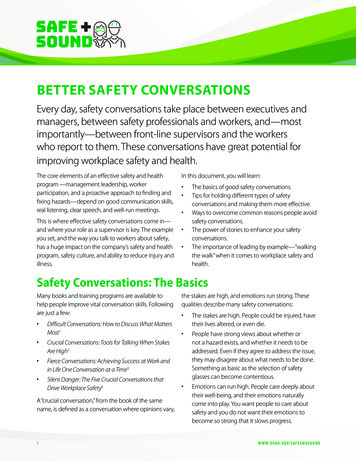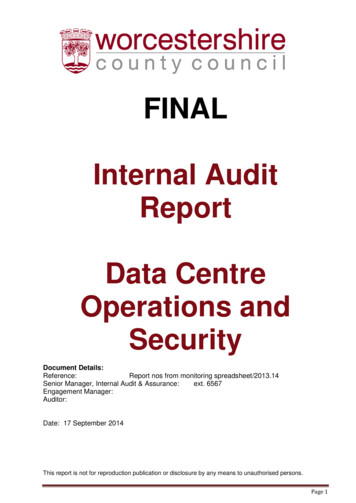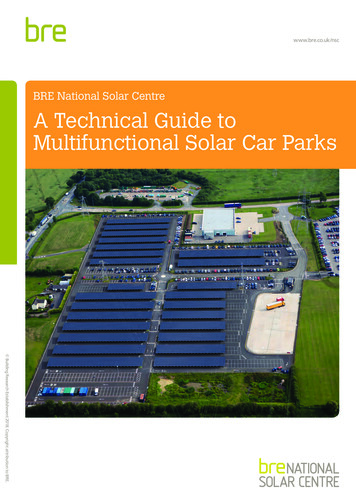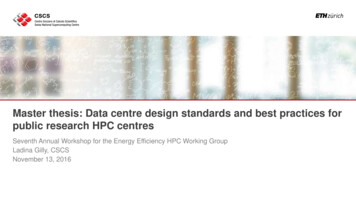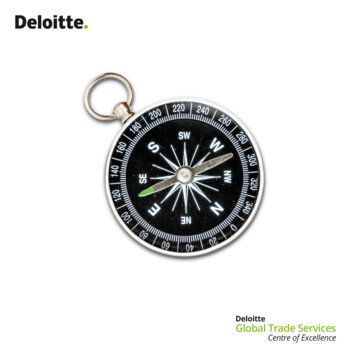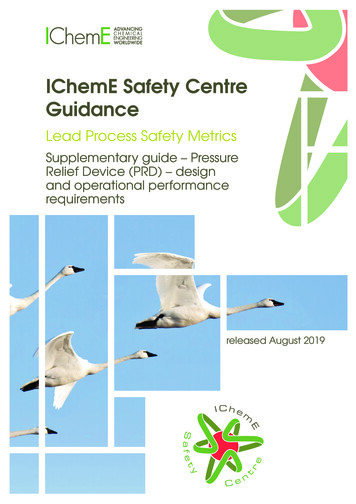
Transcription
IChemE Safety CentreGuidanceLead Process Safety MetricsSupplementary guide – PressureRelief Device (PRD) – designand operational performancerequirementsreleased August 2019IChemEtyreSafetCen
AcknowledgementsISC would like to acknowledge the efforts of the following companies and people who formed the ISC Lead MetricsWorking Group: Amog Consulting – Laurentiu Zamfirescu BHP – Margarita Malaspina BP – Owen Quake Dekra – Wahid Azizi Energy Institute – Lee Allford Orica – Adam Wiles Quadrant Energy – Steven Fogarty ‒ Project Sponsor Rio Tinto – Paul Shardlow Santos – Peter Mennell Santos – Kim Pullon Sherpa Consulting – Jenny Polich Todd Corporation – Roisin Johnson Unilever – Liz Hallifax ‒ Project Sponsor Woodside Energy – Fiona Corbett-MitchellContactthe ISCemail: safetycentre@icheme.org
This document is a supplement to the ISC Guidance Document ‘Lead Process Safety Metrics – selecting tracking andlearning 2015’. This guidance note is used to provide context for barrier failures and in particular the lead metric ‘barrierfail on test’ and ‘barrier failing on demand’. This guidance should be used to help understand the difference betweendesign and operational acceptance criteria. This is the first in a series of guidance documents that will focus on providingmore clarity on the type of failures/events to be included in your metrics and will also aid in the goal of capturing similardata across companies and across industries. This will allow for benchmarking and identification of good practice for usto learn from. As acknowledged by the US Chemical Safety and Hazard Investigation Board, it is important that we focuson lead metrics since the focus on lagging metrics is not a good measure or statistically significant for most companies.PurposePressure relief devices shall protect the system from overpressure/under pressure hazards that could cause lossof containment. The guidance is applicable to protective devices operating across all services.ScopePRD includes devices used to protect pressure vessels, piping, pipelines and tanks from over and under pressure. APIRP 520 and 578 is the accepted harmonised standard for PRD sizing, installation and maintenance. These standardsform the backbone of refrigeration standards. However, refrigeration systems should be designed to either ANSI/IIARor EN 13136 standards as required by local legislation.DefinitionsPRDs ‒ generic term which includes the following:npressure relief valves (PRVs)npressure safety valves (PSVs)npressure vacuum safety valves (PVSVs)nhydrostatic (thermal) relief valvesnbursting disks (BDs)nrupture pin valves (RPVs)and excludes hydrostatic legs, fusible plugs and burst/lift hatches.PassThe device fulfils all the operational acceptance criteria and operational performance testing requirements.Failed safeThe device does not fulfil all the operational acceptance criteria and operational performance testing requirements,does not fulfil any of the failed to danger criteria (eg failed safe: the PSV tag is missing from the devices; however, all theother requirements are met).Failed to dangerThe device does not fulfil any of the operational acceptance criteria or operational performance testing requirements,fulfils any ‘failed to danger’ criteria.3
Design acceptance criteriaThese items are criteria that will need to be addressed in the initial design phase and may need to berevisited as part of the management of change process:n PRDs shall have their set points no higher than the maximum allowable working pressure (MAWP) of thesystem they are protectingn o perating pressure should not be within 10% of the PRDs set point unless device has proven ability to tighter windown selection of the device should match the intended operational fluid, eg clean, dirty, sticky or corrosiven the PRD should be sized for whichever is the largest case, eg fire, tube rupture, blow-by case, blockeddischarge, etc n this sizing case and relevant input data shall be documented on an engineering data sheet or equivalent andconsideration should be given to conducting design verificationn PRD sizing in ammonia refrigeration service should consider excess internal pressure caused by liquidexpansion, internal and external heat source across pumps, vessels and compressorsn the PRD system should be designed so that inlet pressure losses and outlet back pressures are allowed for inthe designn where PRDs relieve to common headers, PSV load calculation shall be performed using reliable two phase flowsoftware to ensure back pressure/choke flow is not created during a relieving scenarion in ammonia service, all PRDs are fitted with dual relief with 3-way valve to allow testing and repair flexibility.Each relief valve must be sufficient to relieve the required rate. 3-way valve stem must be positioned so thatonly one pressure relief is activatedn relief devices that are discharging to atmosphereshall have tail pipe routed to ‘Safe Location’ anddischarge piping shall be designed to preventaccumulation of liquid, fouling, blockage fromvermin and free from restrictionnnnn in case of toxic material release discharge to safelocation should consider use of additionalmitigation steps such as vent stacks and diffusionsystems adequately sized so reduce risk to offsitecommunity valve must remain reseated within 10% of the liftpressure. To achieve this condition, the valve liftpressure may be reduced to 75% or until thevalve re-seats. Reseat tightness checked and thepressure increased to 90% of the lift pressure bursting disks may be installed to provide ahygiene seal upstream of PSV handling and transport of PRD:‒ all valves shall be transported in an uprightposition in purpose built transport frames‒ valves shall be secured to resist shock,impact and movement while in transit‒ valves should be protected from theweather during transport and storage4Typical ReliefVesselPressure VesselMaximum allowableaccumulation pressure,fire sizing121%Maximum allowableaccumulation pressure,multiple reliefs116%Maximum allowableaccumulation pressure,non-fire sizing110%Maximum relievingpressure, fire sizingMaximum relievingpressure, multiplereliefsMaximum relievingpressure,single relief105%Maximum allowableset pressure, multiplereliefsMaximum allowableworking pressure(MAWP)100%Maximum allowableset pressure, singlereliefTypical maximumallowable operatingpressure90%Figure 1: Adapted from ASME Boiler and Pressure Vessel CodeVIII outlines vessel (left) and PRD (right) requirements
Operational acceptance criteriaThese items are criteria that will need to be addressed whilst the equipment is in operation and followingthe operational performance testing activities:n PRD shall be in a free flow path, without blockages, any intervening valves upstream or downstream of anyonline PRV shall be locked openn PRDs shall be maintained in ‘fit for purpose’ conditions and have a valid test certificaten PRDs ‘system’ service conditions shall continue to meet the design input/assumptions and manufacturer’sspecifications. If this is not met, then action should be taken to:– eliminate the root cause– modify the design and/or operating envelope– reduce the inspection/test interval– install a device of more appropriate specification5
Section 1 – PSVs and PVSVsOperational performance testing requirements for PSVs and PVSVs. These activities are required to beconducted by a competent person who is familiar with failure mechanisms and installation requirements:Two activities typically required for testing PSVs, PVSV or thermal relief valves:n online external visual inspection – nominally 12 monthsn scheduled testing and recertification – typically 12‒60 months for pressure vessels, and 10‒12 years for storagetanks, depending on service and prior inspection history:–the interval shall not exceed the internal inspection of the item of pressure equipment it protects– where an ‘as received’ test cannot be conducted due to cleanliness or fouling, the device will be consideredas failed to dangerOnline external visual inspection for PSVs – pass/failcriteria:A PSV test result can be classified as passed, failed safe, or failed to danger, as described below:PassA PSV test result will be deemed as a pass when all have been satisfied:n the correct PSV installed has the correct identification tag number and relieving pressure as per the P & ID ordata sheetn 30% surface corrosion on the pipework or body (as this shows potential for pitting due to coating damage)n there is no blockage/damage or leakage of impulse, sensing, inlet and discharge linesFailed safeA PSV will be deemed to have failed safe if it does not meet the requirements of Section 1 and does not meet therequirements of failed to danger.6n the valve has lost its identification or last recertification tag, but is confirmed as being the correct valve installedn the PSV has 30% corrosion and a passed ‘fitness for service’ assessmentn there is minor restriction/damage of impulse and sensing lines
Failed to dangerA PSV test result will be classified as failed to danger when any of the following have occurred:n the valve has had the tamper proof seals broken or physical damagen the PSV last inspection is not within the certification daten the PSV has failed ‘fitness for service’ assessmentn the PSV has a closed valve or blind installed upstream or downstream of online PRD (typically locked open/carseal/fortress/castell key)n the PSV has blocked/leaking or damaged impulse/sensing linesn the bellows (where fitted) is found to be leaking or damaged, or the vent path is blocked/obstructedn the pilot diaphragm (where fitted) is not found to be leaking or significantly damaged, or the vent path isblocked/obstructedn vent stacks, discharge piping and downstream receiving vessels are not properly supported77
PSV testing and recertification – pass/fail criteria:Conduct periodic inspection and function testing, including ‘pop test’ on the valve in as found condition and visualinspection of valve components. Frequency will be set by API 520 or API 581 if a risk-based approach is taken torecertify PSVs. Depending on your location, there may be other standards, for example, in Australia/New Zealand AS/NZA 3788 is applicable.Reseating of the valve must be tested during recertification.The valve must remain reseated within 10% of the lift pressure. To achieve this condition, the valve lift pressure maybe reduced to 75% or until the valve reseats. Reseat tightness checked and the pressure increased to 90% of the liftpressure.A PSV test result can be classified as passed, failed safe, or failed to danger. 97%97‒103%103‒110% 110%FAILED SAFEPASSFAILED SAFEFAILED TO DANGERPassA PSV test result will be deemed as a pass when all have been satisfied:n its initial ‘POP’ test lifts cleanly within /-3% of its cold differential set pressure (CDSP)n the valve reseats within its acceptable range of 2.5% to -7% of the CDSP, for valves with an adjustable blowdown ring, and -2.5% to -15% for all other valvesn the bubble rate is within the limits set out in API 527. May be dangerous failure if this does not go to flare or ifthe material is toxic and does not go to scrubbern there are no leaks evident during the back-pressure testFailed safeA PSV will be deemed to have failed safe if it does not meet the requirements of Section 1 pass and has not failed todanger:n its initial ‘POP’ test lifts cleanly within 110% to 103% or 97% of its CDSPn the seat tightness test or bubble rate is greater than the limits set out in API 527. May be dangerous failure if thisdoes not go to flare or if the material is toxic and does not go to scrubbern there is minor restriction/damage of impulse and sensing linesFailed to dangerA PSV test result will be classified as failed to danger when any of the following have occurred:n8 the relief pressure is 110% of the CDSP or live lift (if conducted on steam system as per relevant standard)
nupon inspection after disassembly, there is evidence of:– spring damage (incorrect rated spring, reduced spring length, corrosion, scoring or cracking) to the extentthat it may reasonably be expected to cause the valve to fail to open within 110% of its CDSP– fouling, galling or sticking of any components to the extent that it may reasonably be expected to cause thevalve to fail to open within 110% of its CDSP, while in service. For fouling, galling or sticking that could notprevent the PSV from lifting within 110%, the test should be considered to have failed safe– the bellows (where fitted) is found to be leaking or significantly damaged, or the vent path is blocked/obstructed– the pilot diaphragm (where fitted) is found to be leaking or significantly damaged, or the vent path isblocked/obstructed–if PSV is POP type, the valve must not simmer and fully open–blockage or leakage of impulse and sensing linesAPI RP 581 allows operators to adopt a risk-based approach to PRD testing which takes into consideration priorinspection results (eg pass, failed to danger, etc), probability of failure (POF) and consequence of failure (COF) to setthe next inspection frequency for each PRD. A risk-based approach allows for a more quantified approach to risk andguides operators to either reduce testing frequency, allow flexibility to extend inspection timelines and verify whetherreplacement or continued inspection is suited.9
nnSelect typeof devicennnspring loaded PRVbalanced bellows PRVpilot-operated PRVruptured diskotherFail to openn mildn moderateSelect fluidseveritySelect overpressuredemand case(s)severenfire, power failureblacked dischargeloss of cooling water, etcnRBI or equipment databasenEnter PRDinspection historymoderateseverennSelect equipmentitem(s) protectedby deviceLeakagemildnnndatedurationtype of inspectionresultCalculate currentWeibull Parametersfor device leakageDefault Weibull POF curves inthe absence of test dataCalculate currentWeibull Parameters fo
API RP 520 and 578 is the accepted harmonised standard for PRD sizing, installation and maintenance. These standards form the backbone of refrigeration standards. However, refrigeration systems should be designed to either ANSI/IIAR or EN 13136 standards as required by local legislation. Definitions PRDs ‒ generic term which includes the following: n pressure relief valves (PRVs) n
